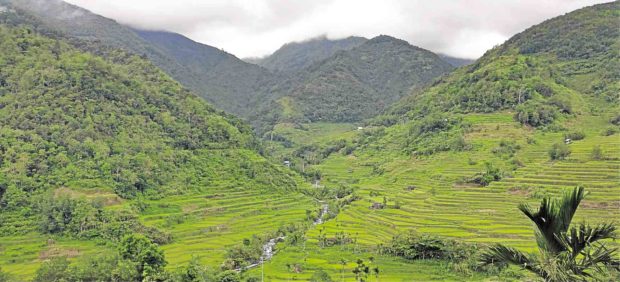Cordillera facing heirloom rice production shortage
BAGUIO CITY – The Cordillera region is facing a potential shortage of its indigenous heirloom rice due to limited farmlands and aging farmers, an official of the Department of Agriculture (DA) said.

HERITAGE SITE The rice terraces of Hapao in Hungduan town, Ifugao province, have been included in the list of Unesco’s World Heritage Sites. These paddies, where heirloom rice is grown, have sustained generations of Ifugaos. —REM ZAMORA
Cameron Odsey, DA-Cordillera regional director said that although upland rice has found a niche market in the country and abroad, only 50 percent of potential areas to grow it are irrigated and farmed.
Records from the DA showed that there are about 14,000 hectares of heirloom rice paddies in the region.
The average yield of the rice grain is 2.32 tons per hectare.
“It is unnecessary to create more farming lands. What we need is to repair, rehabilitate and irrigate existing areas rather than expanding them,” Odsey said at the National Rice Awareness Month conference here on Thursday.
Sonia Pengroso, an heirloom rice farmer from Benguet, said they might not meet the growing demand for the “healthy food.”
Article continues after this advertisementOdsey said only 22.46 percent of the production of this homegrown rice variety is for export and local distribution.
Article continues after this advertisementAt local markets, heirloom rice is sold for P120 per kilogram.
Odsey said a majority of the rice yield is consumed by the farmers and their families.
He said the lack of manual labor has also resulted in a production decline.
Citing DA data, Odsey said the farming population
Farmers are also getting older, with an age range of 50-55.
Odsey also rued the younger generation’s lack of interest in farming.
“We cannot force farmers to grow traditional rice if they don’t want to. But if we are to improve the marketing of heirloom rice and they will earn the same amount as the income from cash crops, that may encourage them to farm rice instead,” Odsey said.
To encourage younger farmers, Odsey said the DA will tap state universities and colleges to include farming in the curriculum of agriculture students.
He said agriculture students may propose a business plan to lending institutions to help them jump-start their own farming business after graduation.
Heirloom rice, compared to commercial rice, is harvested only once a year.
In some areas, planting season is from December to January.
The harvest season is from June to July. The harvest season also coincides with the rainy season which may affect production.
Pengroso said heirloom rice farmers are now focused on increasing their rice production although it requires traditional farming methods and cannot be reproduced through inbreeding.
Inbreeding may change the quality and the DNA of the rice grains, Odsey said, adding that the DA hopes to irrigate existing farming areas to aid with production.